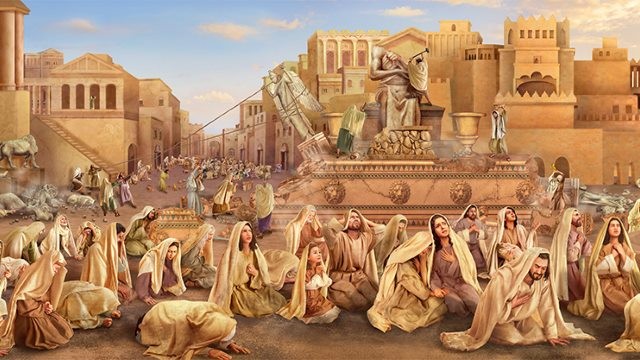
Many first-century Jew would have realised, the climatic end of the book of Jonah is not his miraculous “arising” after being spat out by the fish; it is the much more miraculous repentance of the people in the Gentile city of Nineveh. In a surprising response to the preaching of Jonah, “the people of Nineveh believed God; they proclaimed a fast, and put on sackcloth, from the greatest of them to the least of them” (Jonah 3:5). Even the pagan king of Nineveh is said to have “covered himself with sackcloth, and sat in ashes” before instructing his entire people to “cry mightily to God” (Jonah 3:6-8). It is impossible to overstate how shocking this would have been to a first-century Jewish reader, who would have known that Nineveh was the capital city of the Assyrian Empire, one of Israel’s fiercest pagan enemies (see 2 Kings 15-17). Once we have clearly identified the Ninevites, it becomes obvious that the real miracle in the book of Jonah is the repentance—one might even say the “conversion”—of the Gentiles. And so begins the prophetic evidence for Jonah and the repentance of the nations.
What does all this suggests for how Jesus understands His own death and resurrection? Once the prophetic biblical background of His proclamation about Jonah is clear, everything He says makes perfect sense. To start off with, the scribes and Pharisees demand a “sign” from Jesus—that is, a miracle of some sort meant to prove who He really is (Matthew 12:38). In response, Jesus declares that the only “sign” that will be given to His generation is the sign of the prophet Jonah. What is this miraculous sign? Scholars debate whether it refers to the miraculous rescue of Jonah or the miraculous repentance of the Gentiles. The answer is both. And the same thing is true of the sign of the Son of Man. The “sign of Jonah” is both the resurrection of the Son of Man on the third day and the repentance of the Gentiles that will follow His resurrection. Consider the parallels:
| The Sign Of Jonah | The Sign Of The Son Of Man |
|
|
|
|
What do these parallels mean for what Jesus is saying about His own resurrection? The answer is simple but significant. According to Jesus, it is not just His resurrection from the dead that will be a reason for believing in Him. It is also the inexplicable conversion of the pagan nations of the world—the Gentiles. As Jesus says: the pagans “repented at the preaching of Jonah, and behold, something greater than Jonah is here” (Matthew 12:41; Luke 11:32). In Jonah’s case, only one Gentile city repents, and that only for a time. In Jesus’ case, countless Gentile nations, cities, even empires would go on to repent, cast away their idols, and turn to the God of Israel.
We seem to take for granted that literally billions of non-Jews—that is, Gentiles have abandoned centuries of idol worship and turned to the worship of the one God of Israel. But the same cannot be said for ancient Christians. Over and over again, whenever the early church fathers wanted to make the case for the messiahship, divinity, and resurrection of Jesus, they did not (as a rule) point to the evidence for the empty tomb, or the reliability of the eyewitnesses. They did not get into arguments about historical probability and prophetic evidence and such. Instead, they simply pointed to the pagan world around them that was crumbling to the ground as Gentile nations that had worshiped idols and gods and goddesses for millennia somehow inexplicably repented, turned, and began worshiping the God of the Jews.
From the ancient Christian point of view, not only was the tomb empty. Not only did Jesus appear to many disciples after He died. He also saved what is in many ways the greatest miracle of all for last. The Gentiles began to repent, and convert, and convert. And they are still converting today. The Church is still here, after two thousand years, spreading throughout the world. What began as a little stone “cut out by no human hand” — with one Jew from Nazareth and His tiny band of followers — has indeed become, as the prophet Daniel foretold, “a great mountain and filled the whole earth” (Daniel 2:34-35). What an amazing prophetic evidence this is!